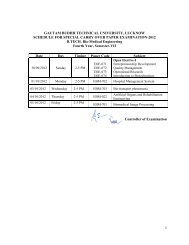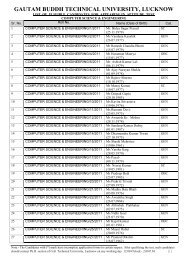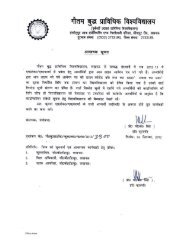NOTE MASTER OF BUSINESS ADMINISTRATION (MBA): The ...
NOTE MASTER OF BUSINESS ADMINISTRATION (MBA): The ...
NOTE MASTER OF BUSINESS ADMINISTRATION (MBA): The ...
You also want an ePaper? Increase the reach of your titles
YUMPU automatically turns print PDFs into web optimized ePapers that Google loves.
Unit II (10 Sessions)<br />
Foreign exchange Market: Nature, structure, types of transactions, exchange rate quotations, spot and forward; Arbitrage.<br />
Foreign exchange market in India: nature, structure, operations, and limitations. Exchange rate determination, forecasting,<br />
theories: Purchasing power parity, Interest rate parity etc.<br />
Unit III (10 Sessions)<br />
Foreign Exchange risk exposure: Types of risk: Economic and translations. Accounting treatment: tax treatment of gains and<br />
losses. Exchange Risk reduction: techniques: applications and their limitations. Hedging, swaps, futures, options.<br />
Relationship of Money market and foreign exchange market<br />
Unit IV (8 Sessions)<br />
Financial structure and International financing: Optimal financial structure and MNE and their foreign subsidiaries;<br />
Eurocurrency markets; International debt markets; Management of interest rate risk: interest rate options, currency options<br />
etc.<br />
Unit V (6 Sessions)<br />
Foreign investment decisions: Multinational capital budgeting; International portfolio theory and diversification;<br />
Repositioning of funds; Working capital management in MNE<br />
FDI and FII in India:<br />
SUGGESTED READINGS:<br />
1) Apte- International Financial Management (Tata McGraw-Hill, 2002) 8 th ed.<br />
2) Eiteman et al- Multinational Business Finance (Pearson Education) 2004,<br />
3) Shapiro- Multinational Financial Management (Prentice-Hall, 4 th edition) 2002.<br />
4) Sharan- International Financial Management (Prentice-Hall, 2 nd edition) 2003.<br />
5) Vij M-International Financial Management (Excel books) ,2003<br />
<strong>MBA</strong>-FM 2: SECURITY ANALYSIS AND INVESTMENT MANAGEMENT Max. Hours: 40<br />
Unit I (6 Sessions)<br />
Overview of Capital Market: Market of securities: Stock exchange and New Issue Market their nature, structure, functioning<br />
and limitations. Trading of securities: equity and debentures/ bonds. Regulatory Mechanism: SEBI and their guidelines.<br />
Investor protection.<br />
Unit II (10 Sessions)<br />
Valuation of Equity: Measures of risk and return: calculation, trade off, systematic and unsystematic. Equity valuation<br />
models. Analysis of equity Investment: Technical and fundamental approaches- company, industry and economy analysis<br />
Nature of stock market: EMH and its implications for investment decision.<br />
Unit III<br />
(10 Sessions)<br />
Other Instruments: Bonds: nature, valuation. Bond theorem; Term structure of interest rates. Duration. Derivatives:<br />
Options and futures: meanings, trading, valuation<br />
Unit IV<br />
(8 Sessions)<br />
Portfolio analysis and selection: Portfolio: concept, risk and return. Beta as a measure of risk: calculation.<br />
Selection of portfolios; Capital market theorem and Arbitrage pricing theory.<br />
Unit V<br />
(6 Sessions)<br />
Portfolio Management and Performance evaluation: Performance evaluation of existing portfolio; Sharpe<br />
and Treynor measures. Finding alternatives and revision of portfolio; Portfolio management and mutual<br />
fund industry<br />
SUGGESTED READINGS:<br />
1) Chandra P- Investment Analysis and Portfolio Management Tata McGraw-Hill, 2004.<br />
2) Fischer and Jordan- Security Analysis and Portfolio Management (Prentice-Hall, 6 th edition) 1996.<br />
3) Ranganatham- Investment Analysis and Portfolio Management (Pearson Education)<br />
4) Pandian P- Security Analysis and Portfolio Management (Vikas)<br />
<strong>MBA</strong>-FM3: MANAGEMENT <strong>OF</strong> FINANCIAL INSTITUTIONS AND SERVICES Max. Hours:40<br />
Unit I (8 Sessions)<br />
Financial system and market: Constituents and functioning. RBI – Role and functions. Regulation of<br />
money and credit. Monetary and fiscal policies. Techniques of regulation. and rate. Foreign exchange<br />
market. Financial sector reforms in India. Financial services: nature, scope and uses etc.<br />
17


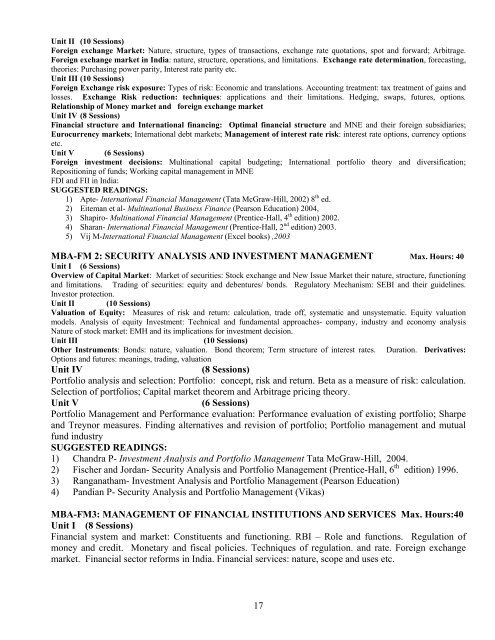

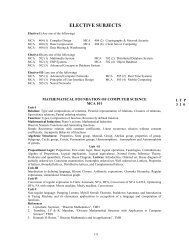

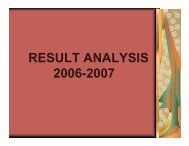

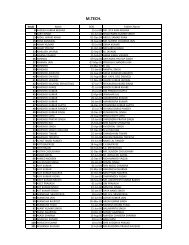

![[MODEL QUESTION PAPER] B-Tech FIRST SEMESTER ...](https://img.yumpu.com/47613205/1/190x245/model-question-paper-b-tech-first-semester-.jpg?quality=85)


